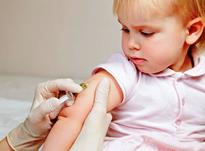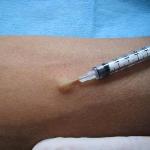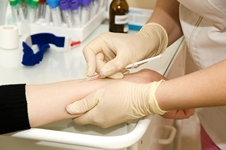 BCG staging technique
BCG staging technique

The TB vaccine is given with the BCG vaccine and is the very first vaccine that a newborn receives in the maternity hospital in the first days of his life. The BCG staging technique is not particularly difficult, but it requires the utmost care, composure and responsibility from the nurse. Only specially trained paramedical personnel are allowed to administer vaccinations.
The decoding of the abbreviation BCG in Russian sounds like “Bacillus Calmette-Guerin”, however, BCG is the “tracing paper” of the Latin abbreviation BCG, which means “bacillus Calmette-Guerin”.
The purpose of BCG vaccination is to prevent tuberculosis. In Russia, the BCG vaccine is administered to children 3 times in a lifetime:
- Vaccination for 3-7 days of life.
- Revaccination I at the age of 7 years.
- Revaccination II at the age of 14 years.
The first and second revaccinations are carried out only in the presence of a negative Mantoux test .
Contraindications for BCG
- Pustular lesions of the skin;
- an increase in body temperature above normal;
- birth injury;
- Rhesus conflict;
- prematurity with a child weighing less than 2000 grams;
- diseases affecting the general condition of the child;
- doubtful or positive Mantoux reaction.
Equipment
- Ampoule with a vaccine.
- Ampoule with a solvent (0.9% sodium chloride solution).
- Syringe with a capacity of 2.0 ml with a needle No. 085 for intramuscular injection.
- Tuberculin syringe with needle No. 0415 with a short cut.
- Ethyl alcohol 70%.
- Sterile tweezers.
- Sterile gauze pads.
- Sterile cotton balls.
- Disinfectant containers.
- BCG vaccination register.
- Developmental history of the newborn or child.
- Black paper cylinder.
The sequence of actions of a nurse
We carefully study the instructions for the vaccine.
We wash our hands, put on a mask and gloves.
We check the integrity of the ampoules, the presence of labels on them, the expiration dates of the vaccine and solvent, and their physical properties. Normally, the solvent should be perfectly transparent, colorless, without the slightest sediment, while the vaccine is a porous powdery mass or a white or cream-colored tablet that should not be wrinkled.
We dilute the vaccine in a 0.9% sodium chloride solution immediately before use:
- we process the necks of the ampoules with a cotton ball moistened with alcohol, file them and wipe them again with alcohol;
- cover the necks of the ampoules with sterile wipes and break them, being careful;
- we collect 2.0 ml of the solvent into the syringe, inject the solvent into the ampoule with the vaccine along the wall, very carefully, in the amount of 2.0 ml - into the ampoule with 20 doses and 1.0 ml - into the ampoule with 10 doses;
- we draw a suspension into the syringe and mix the vaccine with reciprocating movements of the piston;
- the dissolved BCG vaccine is introduced into the ampoule;
- the syringe and needle are immersed in a container with a disinfectant solution.
The ampoule with the vaccine is placed in a black paper cylinder, covered with a sterile napkin.
We draw 0.2 ml into the tuberculin syringe, i.e. 2 doses of reconstituted vaccine.
We release 0.1 ml of vaccine into a sterile cotton ball or swab through a needle, displacing air and bringing the syringe plunger under the 0.1 ml mark.
A cotton swab with the vaccine released into it is placed in a container with a disinfectant solution.
We treat the child's skin with a cotton ball soaked in 70% alcohol twice on the outer surface of the left shoulder in the region of the border of the upper and middle thirds.
We introduce the vaccine strictly intradermally . With the correct injection technique, a whitish papule is formed, the diameter of which should be at least 5-6 mm, the papule disappears after 15-20 minutes. When removing the needle, DO NOT treat the skin with alcohol!
The syringe with the needle is immersed in containers with a disinfectant solution.
We warn the mother of the child that the injection site should never be treated with disinfectants or bandaged.
Remove gloves, place them in a container with disinfectant, wash your hands.
Necessarily! We register the vaccination in the history of the development of a newborn (f. No. 097 / y) or the history of the development of the child (f. No. 112 / y), in the registration form 063 / y, for organized children - also in f. No. 026/u. We also register the vaccination in the BCG vaccination register. In all medical documentation, we indicate the date of the vaccination, the age of the child, the series, the expiration date, the dose of the vaccine and the name of its manufacturer.
Notes
- The diluted vaccine is usable within 2 hours.
- Unused vaccine is destroyed by immersion in a disinfectant solution or by burning.
- The response to the introduction of the BCG vaccine is evaluated after 1, 2, 3, 4, 5, 6, 9 and 12 months from the moment of administration.
Reaction to the introduction of the BCG vaccine
In a newborn, after 4-6 weeks, an infiltrate appears at the injection site with a small nodule in the center with a diameter of 5-10 mm, with or without a crust.
In revaccinated children, a local reaction develops after 1-2 weeks, sometimes spot necrosis with serous-purulent contents is possible.
In 90-95% of vaccinated children, a superficial scar up to 10 mm in diameter should form at the injection site no later than 1 year.
Complications after BCG vaccination
- Formation of a cold abscess.
- Formation of a keloid scar.
- Lymphadenitis.
- Formation of tuberculous osteomyelitis.
- Ulcer on the skin with a diameter of 10 mm or more.





